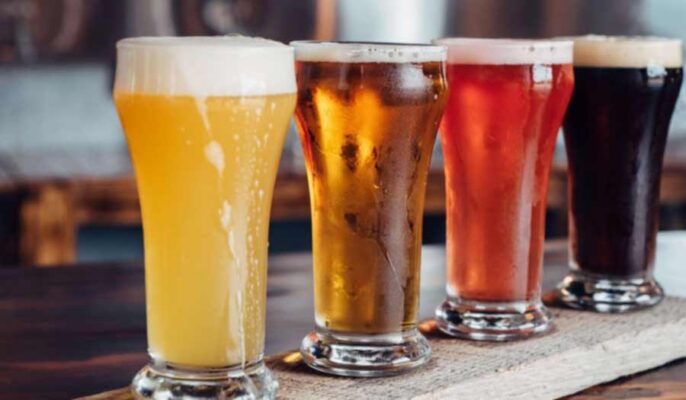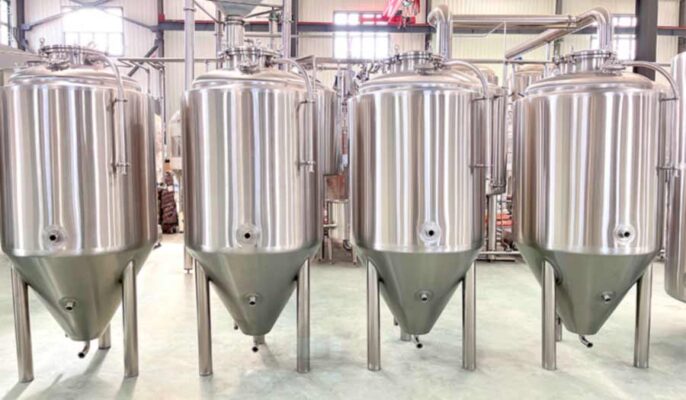Many factors go into brewing the perfect beer, and fermentation control is one of the most important aspects that is often overlooked by novice brewers. It is during this stage that the yeast converts the sugars in the malted grains into alcohol, carbon dioxide, and other flavors that give the beer its unique taste. Without fermentation, beer is sweet, unfermented wort. But, depending on the ambient temperature of the fermentation area, you may need to heat or cool the fermenter to maintain optimal temperatures.
Fermentation in beer brewing
Fermentation process
Fermentation is a critical stage in the beer brewing process. This is the process by which yeast converts glucose in the wort into ethanol and carbon dioxide gas. This gives the beer its alcohol content and carbonation. The fermentation process usually begins a day or two after brewing and can be identified by observing bubbles in the airlock and a thick layer of foam (called clausen) on top of the beer.
Yeast strains
A variety of yeast strains are used in beer fermentation, and they play an important role in determining the flavor and texture of the final product. The two main types of yeast used in beer brewing are:
- Ale yeast: This yeast is used in the fermentation of ale beer. It performs best at higher temperatures, between 60°F and 80°F.
- Brewer’s yeast: Brewer’s yeast is used to ferment beer. It can tolerate high alcohol concentrations and has a lower optimal fermentation temperature range than ale yeast.
Alcohol content
The alcohol content of beer depends on the yeast strain used and the fermentation process. Generally, ales have a higher alcohol content than lagers because ale yeast can tolerate higher alcohol concentrations.
It is important to allow enough time for fermentation to complete. When brewing beer, it takes about two weeks to ferment before it is transferred to kegs or bottles. After bottling, the ale takes about two weeks to become carbonated and clear. Beer, requires an extra two to four weeks to mature.

Why control fermentation temperature?
Fermentation temperature control is the single factor that has made the most progress in beer brewing. Generally speaking, typical malt yeast performs best in the 66-72°F range. This is the best place to make sure your brewer’s yeast doesn’t create too much of a bad smell. Yeast will thrive and multiply faster in warmer temperatures, but will produce more esters in the process. We can avoid this by controlling the fermentation temperature.
Off-flavors are often associated with uncontrolled fermentation temperatures:
- Fusel alcohol: Often thought of as a hot alcohol flavor that almost tastes like wine or vodka. This smell can be removed during next conditioning.
- Lipid: Usually thought of as fruity, banana, pear or nail polish remover. Although certain lipids are desirable in certain styles of beer, they should not be present in other styles of beer. The flavor of lipids also fades during conditioning, but if present in too much, it may never improve over time.
- Aldehyde: Often associated with the smell of green apple, raw pumpkin, or pumpkin. Acetaldehyde is a natural by-product of the fermentation process, but if the temperature is not controlled, excess will occur and affect the flavor of the beer.
The above-mentioned off-flavors are natural by-products of the fermentation process and occur with every fermentation. They cannot be detected under ideal fermentation conditions.
Learn about the different controlled fermentation temperatures
When brewing, temperature control is crucial. Fermentation temperature has a great impact on the quality and flavor of beer. Different beer styles need specific fermentation temperatures (40 to 70 °F) for optimal flavor and quality. Managing the temperature within the fermentation vessel is crucial as it prevents the production of sub-par beer.
Additionally, it is important to maintain target fermentation temperatures during the brewing process to ensure consistent results and reduce the chance of unexpected results.
Let’s take a look at the ideal fermentation temperatures for various beer styles:
- The optimal temperature range for ale is 68-72°F
- The optimal temperature range for lager beer is 45-55°F
- The optimal temperature range for isopropyl alcohol (India Pale Ale) is around 65°F
- The optimal temperature range for stout is around 64-67°F
- Pilsner is fermented at a temperature range of 50-55°F
- The optimal temperature range for Box is 50-52°F
What happens when fermentation temperatures get higher?
- The biggest problem that occurs when the fermentation temperature is too high is the odor of lipids and fusel alcohols produced by yeast. Sometimes these off-flavors can be “too much” because they don’t suit the style of beer.
- Your yeast will undergo a strong metabolic reaction, eating everything in front of you, but it will run out of nutrients before eating the sugar. This situation often results in incomplete fermentation.
- Poor fermentation temperature control usually results in too high a fermentation temperature, making the yeast too sensitive to alcohol toxicity. This means the yeast will die from the alcohol before it reaches tolerance.
- The yeast dies due to heat stress at the beginning, and only the remaining yeast can do all the work. This condition will reduce the amount of yeast, lengthen the time required for the fermentation process, and may even make the beer taste worse.
- Because yeast generates a lot of heat during its metabolic process, the beer begins to ferment at an high temperature, and the temperature will climb to 80°F, causing the death of the yeast.
What happens when fermentation temperature gets colder?
- Yeast can also suffer from various problems when brewing in cold climates or during the winter without temperature control. Winter is traditional brewing time. This is because there are less spoilage and wild bacteria to deal with in the winter. For homebrewers, fermentation temperatures that are too low can cause the following problems:
- Fermentation may never start.
- Fermentation can be very slow and last for weeks, running into trouble.
- For ales that need a certain degree of fatty fruit flavor, fermentation temperatures that are too low can result in a beer that is too clean or too bland in style.
- If there is any contamination in your beer then you will have to start brewing a new beer. A slow start to fermentation due to poor temperature control can give bacteria a chance to take over and ruin a batch of beer.
When fermentation begins in a cooler environment, carbon dioxide may become entrained in the beer. Often, “degassed” flavors remain in solution and may affect the final product formed throughout the fermentation process. This is especially true for the “sulphur” aroma and flavor produced during beer fermentation.

How do wineries control fermentation temperature?
The key to brewing high-quality beer depends on attention to detail. Besides to selecting the ideal yeast strain, selecting and maintaining the optimal brewing temperature is also critical to achieving the desired beer quality. While beer fermentation temperatures in homebrew equipment can be controlled using a simple cooling fan and bathtub, commercial-scale beer fermentation temperatures need special temperature regulation equipment. Brewery chillers are ideal for large-scale beer production.
Most brewery coolers use an aqueous solution of ethylene glycol as the coolant (other refrigerants may also be used). These chillers offer the following advantages:
- Ethylene glycol helps prevent circulation pipes from freezing at low temperatures and clogging the chiller.
- Ethylene glycol has lubricating properties and can be used to keep cold water meters running .
- Ethylene glycol retains heat better and helps cool brews.
How to watch fermentation temperature?
Monitoring and adjusting fermentation temperature is a critical step in the brewing process. By paying close attention to fermentation temperatures and adjusting as needed, you can ensure that your beer is fermenting at the optimal temperature for your specific style and yeast strain.
Temperature probe
A digital thermometer, for example, is an instrument used to measure fermentation temperature. They are crucial because they allow brewers to check fermentation temperatures, which is crucial for achieving ideal results.
Active fermentation change
Active fermentation adjustments involve changing the temperature during fermentation to get desired results or to prevent contamination.
Some active fermentation adjustments for monitoring and adjusting fermentation temperature include:
- Use a self-adhesive thermometer to watch the temperature of the fermentation vessel
- Adjust the temperature by moving the temperature control tape up and down on the side of the fermenter
- Start fermentation at a lower temperature than the target ideal temperature and increase the temperature over time
- Watch temperature and adjust as needed
By implementing these active fermentation adjustments, you can control your fermentation temperature and maintain optimal fermentation temperature control for better brewing results.
FAQ
What is the ideal temperature for fermentation?
For best results, the optimal fermentation temperature range is 18-22°C/65-72°F, as lower temperatures will slow down the fermentation process, while higher temperatures may speed it up.
How low is the fermentation temperature?
For beer and wine, fermentation temperatures range from 55°F to 85°F, while sake can be fermented at temperatures as low as 32°F.
How long does it take for beer to ferment?
Beer fermentation usually takes four to eight weeks to complete. The duration depends on factors such as the type of yeast and the specific recipe used. Keep in mind that fermentation times may vary and following the winemaker’s instructions is critical to achieving the desired results.
What is the best equipment for beer fermentation?
Choosing the right fermentation equipment depends on your brewing preferences and budget. Common options include plastic fermenters, glass carboys, and stainless steel conical fermenters. Each has its own advantages, plastic is cheaper, glass provides better clarity for monitoring fermentation, and stainless steel is durable and easy to clean.




